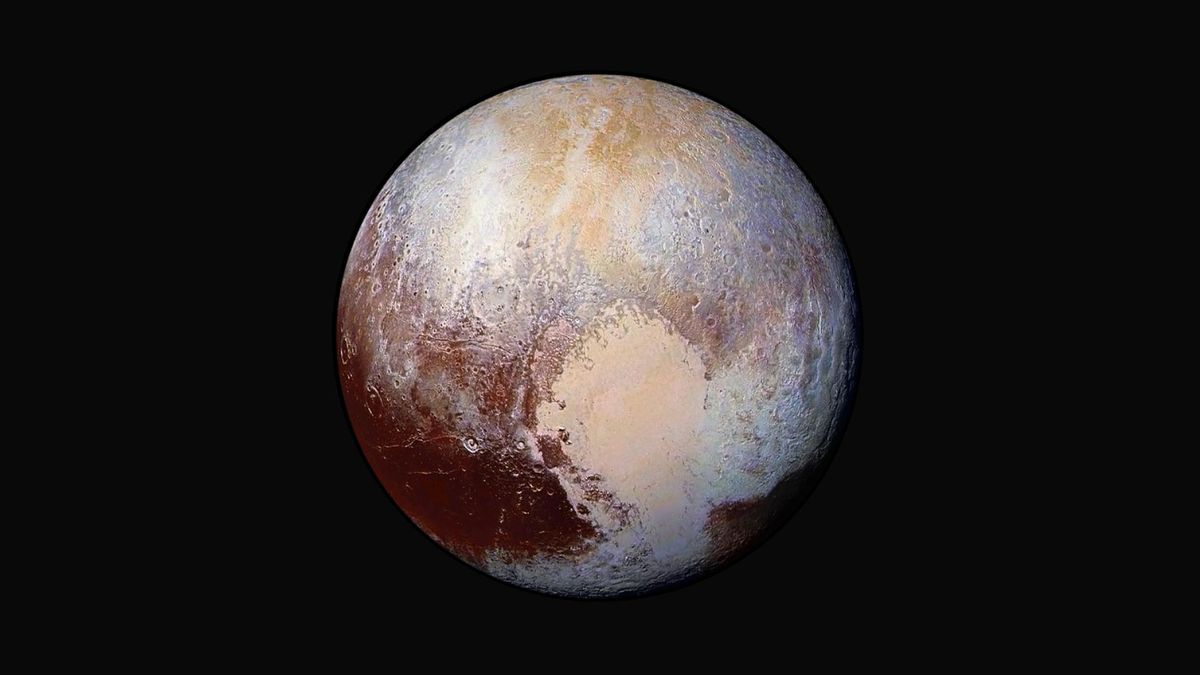When NASA’s New Horizons mission flew past Pluto in 2015, it gave humanity our first glimpse of a colossal depression on the isolated world. It’s named Sputnik Planitia. Comparable in size to the country of Mexico and dominating one of Pluto’s hemispheres, Sputnik Planitia is likely the result of an impact — but few impact craters come in Sputnik Planitia’s unique pear-like shape.
How Sputnik Planitia formed remains unknown, but researchers have now painted a possible picture of its origins. It’s possible, they say, that a body about the size of Switzerland crashed into Pluto long ago, at a shallow angle. If true, this picture would also hint at what Pluto’s interior may look like under its cryogenic surface.
Related: Why is Pluto not a planet?
“Most thought Sputnik Planitia was of impact origin, but nobody had been able to explain its distinctive pear shape,” Harry Ballantyne, an astronomer at the University of Bern in Switzerland, told Space.com.
Sputnik Planitia’s shape and colossal size — roughly 2,000 kilometers long (1,243 miles long) and 1,600 kilometers wide (994 miles wide) — are not the only reasons planetary scientists have looked at it with curiosity. Whatever created this formation managed to carve out a dent as deep as s 4 kilometers (2.5 miles); and at the bottom of the chasm appears to be a frozen expanse of nitrogen ice. Gravity ought to have slowly rotated Pluto such that the dent and its missing mass ended up at one of Pluto’s poles — but, oddly enough, Sputnik Planitia remains around the equator.
One popular theory suggested that Sputnik Planitia was actually a hint of a global ocean buried under Pluto’s surface. After a massive impact, liquid water from the ocean might have risen to fill the gap, which would have then been iced over with a nitrogen coating — explaining why Sputnik Planitia stayed on the equator. Still, some scientists remained unconvinced.
“I had never bought into the idea that Sputnik ending up on the equator requires a global ocean,” Erik Asphaug, an astronomer at the University of Arizona, told Space.com. “In my view it’s much easier to explain it if you start and end with a solid body that can sustain this kind of splat.”
So, Asphaug, Ballantyne and their colleagues set about conducting three-dimensional simulations to learn what circumstances might have given rise to Sputnik Planitia. The feature’s strange shape was a hint that the dent’s creator struck Pluto obliquely, rather than head-on. That led them to simulate a 700-kilometer-wide (435-mile-wide) object — a ball of ice and rock — striking a Pluto-like world. This object was made to exhibit a rocky core within a water-ice shell too, and the impact was imparted at a shallow 30-degree angle. Indeed, not only did this scenario lead to a pear-shaped crater, but the team’s simulations indicated that the core of the impactor remained buried under Sputnik Planitia, giving it the extra mass it needed to remain on the equator.
The authors say that future research is still needed to expand on these concepts, both to understand how Sputnik Planitia evolved over billions of years and how collisions work in this distant corner of the solar system.
“There’s still a lot to learn about planetary collisions,” Adeene Denton, a planetary scientist at the University of Arizona and another of the paper’s authors, told Space.com. “And for the Kuiper Belt in particular, there are many uncertainties for what happens when icy and rocky bodies collide.”
Pluto’s interior may help us understand those dynamics at last, but for more definite answers, we may have to wait for another mission. Although New Horizons’ visit to Pluto was a remarkable feat, the probe did not do any more than simply fly by, meaning that the mission, very literally, only scratched the former planet’s surface. A future mission may be able to orbit Pluto and probe its interior by, for instance, measuring the world’s gravitational field.
“We need the kind of geophysical data that’s been collected around the Moon and Mars that have allowed us to determine the internal structure of those bodies in such detail,” Denton told Space.com. “There’s a lot of information to be gained about Pluto’s interior, and orbiting Pluto is the best way to do it.”
The researchers published their work in the journal Nature Astronomy on April 15.

Dr. Thomas Hughes is a UK-based scientist and science communicator who makes complex topics accessible to readers. His articles explore breakthroughs in various scientific disciplines, from space exploration to cutting-edge research.








